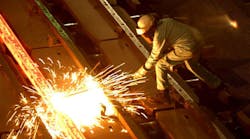Worker productivity rose in the third quarter by the most in two years as the economy picked up steam, offering a respite from the weak efficiency gains that have defined the U.S. expansion.
The measure of employee output per hour increased at a 3.1% annualized rate, after a revised 0.2% drop in the prior three months, Labor Department figures showed Thursday. The median forecast in a Bloomberg survey called for a 2.1% gain. Expenses per worker climbed at a 0.3% pace.
The productivity data represent a break from the longest consecutive string of declines since 1979, as employers squeezed more output from existing workers. Efficiency was little changed over the last 12 months, consistent with the long-term downtrend as businesses have been reluctant to invest in equipment, relying instead on more hiring.
“Businesses got increased output without increased costs, that’s good for them,” David Sloan, senior economist at 4CAST-RGE in New York, said before the report. “But it’s just one quarter so we can’t get too excited about it. The overall picture for productivity is still quite weak.”
Economists’ estimates for third-quarter productivity ranged from no change to a gain of 3.1%. The reading for the prior quarter was initially reported as a drop of 0.6%.
Over the last five years, annual productivity gains averaged 0.6%, the weakest since 1978-1982.
Unit labor costs, which are adjusted for efficiency gains, were forecast to rise an annualized 1.2%, according to the Bloomberg survey median. They rose 3.9% in the prior quarter, revised from a previously reported advance of 4.3%.
Adjusted for inflation, hourly earnings rose at a 1.7% rate, after increasing at a 1.2% pace.
Output climbed at a 3.4% rate, the most in two years, following a 1.6% gain the prior quarter.
Hours worked rose at a 0.3% pace, the weakest in a year, after a 1.7% advance.
Factory Productivity
Among manufacturers, productivity increased at a 1% rate in the third quarter after a 0.5% decrease.
The world’s largest economy expanded at a 2.9% pace last quarter after an uninspiring first half of the year as the rebuilding of inventories and a soybean-related jump in exports helped cushion softer household spending.
Persistent weakness in productivity is among the concerns noted by Federal Reserve policy makers. The central bank, which kept the benchmark interest rate unchanged at its meeting that ended Wednesday, is weighing whether to increase it in December.
Weak efficiency, in addition to crimping corporate profits, limits economic growth from gaining momentum in the longer term.
The pace at which an economy can expand without stoking inflation -- which economists refer to as its speed limit -- reflects the rate of growth of the labor force and how much each worker can produce.
While economists attribute weaker productivity to a host of reasons including lack of adequate capital investment and a cooling pace of innovation, there’s also a debate about how accurately the changes in productivity are being measured.
By Shobhana Chandra



